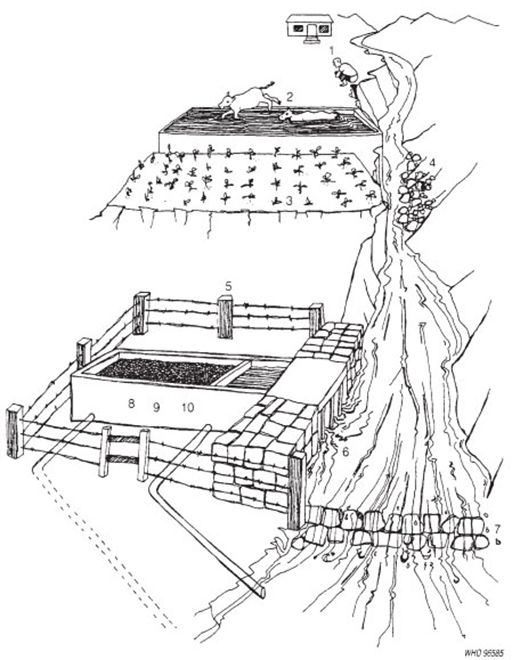12.2 Inspection of an abstraction point at a river
In Study Session 3 you considered the different types of water sources and learned the significance of the term ‘protected’.
What is a protected water source?
It is a water source that has structures to prevent the entry of physical, chemical and biological contaminants.
You have learned about the different ways in which wells, boreholes and springs can be protected. Surface waters, on the other hand, are difficult to protect because run-off can wash pollutants (such as faecal matter) off the surface of the ground and take it into rivers and lakes. Activities in a given catchment are difficult to control and so substances such as pesticides and fertilisers used by farmers, and other activities such as washing clothes and even vehicles in a river or lake, can contribute to pollution of these water sources. A sanitary inspection can identify the sources of pollution so that protective measures may be implemented.
For many towns and cities the water supply originates from a river, usually several kilometres from the town or city centre. Figure 12.1 depicts a river water abstraction point, with a filter to pre-treat the water before it is pumped away for fuller treatment. The abstraction point should have a fence to keep people and animals away. The figure shows what a technician should be looking for when undertaking a sanitary inspection, and Box 12.1 gives a checklist of questions to consider. The numbers in the figure demonstrate particular points and correspond to questions in the checklist. The number of ‘Yes’ answers to the questions indicates the risk of contamination.

Box 12.1 Example checklist for inspection of an abstraction point at a river
- Is there any human habitation upstream, polluting the source? Yes/No
- Are there any farm animals upstream, polluting the source? Yes/No
- Is there any crop production or industrial pollution upstream? Yes/No
- Is there a risk of landslide or mudflow (caused by deforestation) in the catchment area? Yes/No
- Is the intake installation unfenced? Yes/No
- Is the intake unscreened? Yes/No
- Does the abstraction point lack a device such as a dam so that water flows into the box at 8? Yes/No
- Does the system require a sand or gravel filter because the water is silt-laden and can affect water treatment? Yes/No
- If there is a filter, is it functioning badly? Yes/No
- Is the flow uncontrolled? Yes/No
Total number of ‘Yes’ answers = contamination risk score:
9–10 = very high
6–8 = high
3–5 = intermediate
0–2 = low.
Name ______________________
Signature ______________________
Date ______________________
12.1.1 Duties of a sanitary technician
